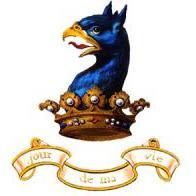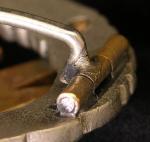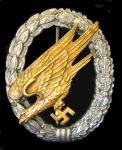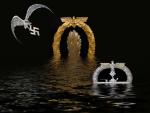-
Posts
3,397 -
Joined
-
Last visited
-
Days Won
3
Content Type
Profiles
Forums
Blogs
Gallery
Events
Store
Everything posted by J Temple-West
-
For those who consider Deumer parts badges to be of a higher quality than those from Juncker. Unlike the majority of Deumer marked badges which were produced with parts supplied by C.E Juncker, this is one of those early all Deumer parts pieces. The materials used; Wreath: Nickel Silver. Eagle: Brass. Obverse
-

Luftwaffe GCB Maker Opinion
J Temple-West replied to ERIC's topic in Germany: Third Reich: Wehrmacht Medals, Decorations & Awards
I can find absolutely nothing wrong with this piece, Eric. As to the round catch-plate... although uncommon for use with the LGCB, quite a common sight on other ?Juncker? badges. Nice piece, nice find. -
Nice thread, Gordon. Here's a little more info on her war time record. Laid down 28 Oct, 1944 Blohm & Voss, Hamburg Commissioned 24 Feb, 1945 Commanders 24 Feb, 1945 - 4 May, 1945 Oblt. Rudolf Schultze Career No patrols 24 Feb, 1945 - 4 May, 1945 31. Flottille (training) Successes No ships sunk or damaged
-
Is there a metallurgist in the house? Generally, hinge and catch systems were soldered to the badge. On early nickel silver/tombak/buntmetal badges, the soldering process was quite easy as the manufacturers were working with high grade metals, which meant that the attaching of parts to badges could be made with small amounts of solder. As the war progressed, these high grade metals became harder to come by due to the demands of the war machine and alternate, lower grade metals were utilized in the production of non essential items such as medals and awards. On the introduction of zinc, it was found that conventional hinge/catch assemblies were harder to attach as it needed a larger amount of solder to make the parts stable. This is when the use of hinge and catch plates came in to existence. Instead of soldering the hinge/catch directly to the badge, these parts were first soldered to the plate, and then the plate attached to the badge. This gave a larger area to work with and a much more stable platform. So, this is why you see a difference in reverse setups on early/late badges. The general rule is? If the badge has a hinge/catch plate, it?s zinc and a late piece. Of course there are exceptions, with certain makers using their own methods in an effort to combat the problems of attaching parts to their zinc badges in the form of riveting, making the hinge an integral part of the die, soldering the catch into a recess in the badge, etc. Your "Juncker" shows one of the typical setups for their zinc series. As well as the oblong catch plate, Juncker also used a round plate on many of their badges, another characteristic to look out for. Hope this makes sense.
-
Hi John, The list is as follows; C.E Juncker. W.Deumer. GWL BSW G.H Osang. P. Meybauer. B&NL. F.W Assmann. JMME & Sohn. Unknown Maker.. Unmarked. All the maker marks can be found through the link.. http://gmic.co.uk/index.php?showtopic=616 There is also a pretty comprehensive thread on the subject, should you need pix of originals for comparison. http://gmic.co.uk/index.php?showtopic=595
-
I find the ?Honour Goblet? quite confusing. Yes, we have a stunning, fully marked 835 silver goblet. We also have a picture, supplied by Jacques, of what appears to be a different goblet in the later silver plate (alpaca) form, both with the same dedication and seemingly engraved by the same hand. Not a good sign. As far as the date (August ?42) is concerned? It doesn?t seem to tie up to anything of interest, as far as I can see. Dates. M?lders date of birth. 18th March 1913. Awarded Knights Cross. 27th May 1940 Awarded Oak leaves. 20th September 1940 Awarded Swords. 22nd June 1941 Awarded Diamonds. 15th July 1941 100th kill. ? ? Death. 22nd November 1941 JG 51 was bestowed the honour name "M?lders". 20th December 1941. I have looked through everything I can find on M?lders and can find no mention of a goblet having been awarded. Seeing that he was on a ?fast track? to be being made a Nations Hero, I would have thought that every minute detail would have been documented. As far as the photo?s with A.H are concerned, all part of the propaganda machine. I bet the caption would read something like ? Our beloved Fuhrer seen with the Luftwaffe?s Air Ace, Werner "Vati" M?lders. My questions would be; Why would Hitler make a presentation, with such a personal dedication, to the squadron that were bestowed the honour title of ?M?lders? some eight months before. If the goblet had been dated to coincide with the honour naming, I would have found the piece a little more convincing. Why is there more than one goblet? If more than one goblet was made, why would there one in pure silver and another in the later silver plate? Possible answers; The silver example is genuine, (this would be the quality expected of a gift from the Fuhrer) which is going to be extremely hard to prove without provenance. That someone, post-war, has bought up a quantity of unnamed goblets (both silver and alpaca) and had them engraved. This, IMO, is the most likely explanation. Again, this is only an opinion and some thoughts. I am sure that there will be someone who will have the answer. In the meantime, keep up the research and keep us informed on any developments.
















